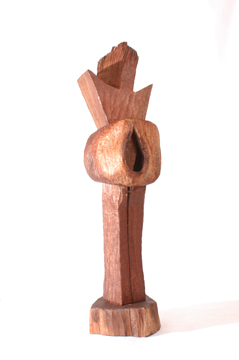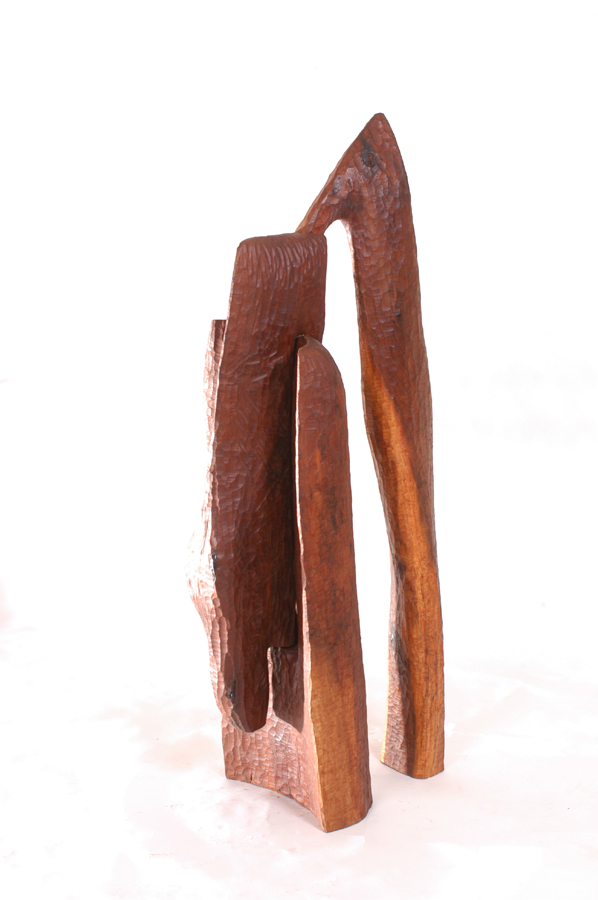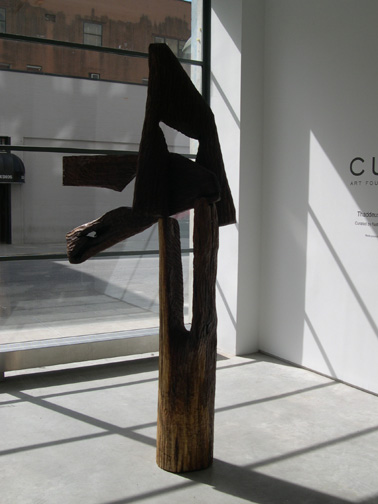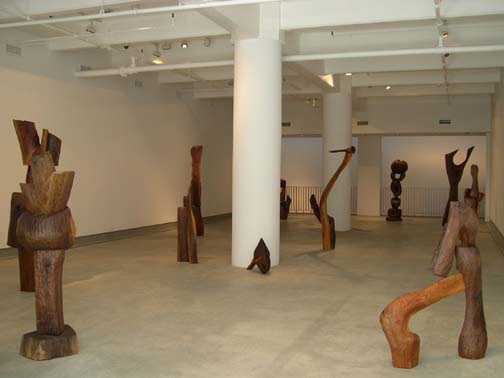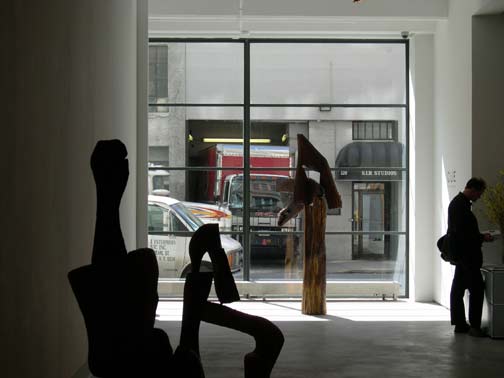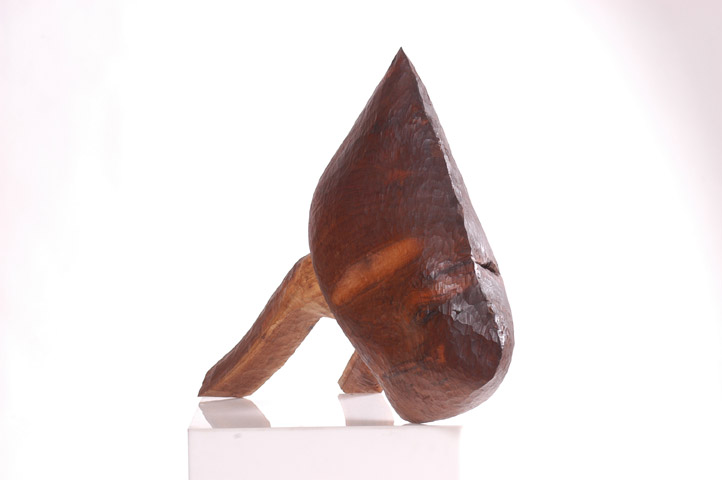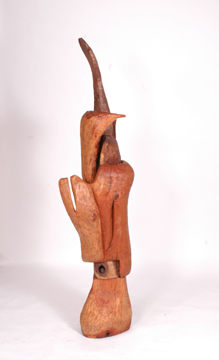Thaddeus Mosley
Curated by Nathaniel Mackey
January 29 – March 6, 2004
Thaddeus Mosley was born in New Castle, Pennsylvania, in 1926. Following high school and a stint in the Navy, he enrolled at the University of Pittsburgh, where he graduated in 1950 with a double major in English and Journalism. Mosley then went to work for the postal service, from which he retired in 1992. During the 1950's, he additionally did freelance journalism for The Courier and for several national magazines; he also began making sculpture. Since that time, his work has been shown in numerous exhibitions, including a solo exhibition at the Carnegie Museum of Art, Pittsburgh, PA. Mosley lives and works in Pittsburgh, PA.
Nathaniel Mackey was born in Miami, Florida in 1947 and grew up, from age four, in California. He is the author of three books of poetry: Eroding Witness (University of Illinois Press, 1985), School of Udhra (City Lights Books, 1993) and Whatsaid Serif (City Lights Books, 1998). Strick: Song of the Andoumboulou 16-25, a compact disc recording of poems read with musical accompaniment (Royal Hartigan, percussion; Hafez Modirzadeh, reeds and flutes), was released in 1995 by Spoken Engine Company. He is the author of an ongoing prose composition, From a Broken Bottle Traces of Perfume Still Emanate, of which three volumes have been published: Bedouin Hornbook (Callaloo Fiction Series, 1986), Djbot Baghostus's Run (Sun & Moon Press, 1993) and Atet A.D. (City Lights Books, 2001). Mr. Mackey is the editor of the literary magazine Hambone and coeditor (with Art Lange) of the anthology Moment's Notice: Jazz in Poetry and Prose (Coffee House Press, 1993). He is also the author of a book of critical essays,Discrepant Engagement: Dissonance, Cross-Culturality, and Experimental Writing (Cambridge University Press, 1993). His awards and honors include the selection of his first book of poetry, Eroding Witness, for publication in the National Poetry Series, a Whiting Writer's Award in 1993 and election to the Board of Chancellors of the Academy of American Poets in 2001. Nathaniel Mackey is Professor of Literature at the University of California, Santa Cruz.
ARTIST'S STATEMENT
My sculpture is an urban Afro-American-Euro-Jazz influenced art. It is an effort to create works of vitality and identity which enhances space and transcend time. Although I sometimes work in stone, mixed media-found metals, the primary material is wood; cherry walnut and other hardwoods.
CURATOR'S STATEMENT
by Nathaniel Mackey
I was introduced to Thaddeus Mosley's work by Ed Roberson in the late nineties. It was the third time in the past twenty or so years that a poet pointed me in the direction of a sculptor's work. John Taggart made me aware of the work of Bradford Graves in the early 1980s and Ethelbert Miller, while I was writer-in-residence at the Washington Project for the Arts in 1986, insisted I see an exhibition of Ed Love's work that was on display at Howard University. John said Graves's tributes to and evocations of such musicians as John Coltrane, Ornette Coleman and Thelonious Monk would interest me, Ethelbert that Love's references to Egyptian, Yoruba, Dogon and other African traditions would resonate with my own moves in that direction. I don't recall precisely what Ed said when he first mentioned Mosley's work, though he may well have spoken of a spectral, spiritual abstraction found in many of the pieces, the articulation of voided space that he since has written brilliantly about in the pages of my journalHambone, an extension by way of excision that would have spoken, implicitly at least, to my repeated recourse to the phantom limb as a figure for art's work and wonder. In any event, he brought Mosley's work to my attention and I couldn't be more thankful that he did.
That a writer put me in touch with Mosley's work is apt. Mosley majored in English and journalism in college, has dedicated sculptures to Countee Cullen and Langston Hughes, sculpted a piece whose title invokes Stephen Crane and so forth, but the aptness has to do not only with that. It has to do as well with a writing before writing out of which writing must have come, some first inclination to invest impression or imprint that Mosley's work, in the salience it affords gouge and incision, especially in what appears to me to be his signature medium, wood, seems to hark back to. A first befriending of wood and a first befriending of stone seem active and alive still as well. I was struck, reading David Lewis's Thaddeus Mosley: African-American Sculptor a few years ago, by Mosley's insistence that he doesn't generate his sculptural themes by himself: "My woods and stones and I generate themes together. When I bring in a load of logs or blocks of stone, I stack them up in the studio... Everytime I go to my workbench I walk by them and get to know them better." I'm reminded of mbira music among the Shona of Zimbabwe, the sense of a dialogue or duet between musician and instrument that Dumisani Maraire, an mbira player, has commented on: "What the mbira player is doing is he has a friend, the mbira. This friend is of the same musical quality with him. He teaches his friend what to do and his friend teaches him what to do." Mosley's getting to know wood and stone is, to all our benefit, such a befriending.
Not having attended art school, Thaddeus Mosley is what's commonly known as a self-taught artist. Another statement of his, bearing on this, has stayed with me: "Every artist, in the end, must be self-taught because everyone must go beyond the lessons of other people's work." That Mosley is also self-taught in this more uncommon sense is evident in his work's divergence from that of Constantin Brancusi and Isamu Noguchi, two of his threeannounced influences, and from the third, African sculpture, as well. He has gone far beyond the symmetries, regularities and smooth geometries of such work, pursuing jagged compositions which emit a sense of uneasily arrived at repose, precarious balance, a steadiness perhaps caught between staggers. Complicating the perpendicular amenities of such work, his pieces partake of tilt, bend, lean, asymmetric poise, flirting with totter, flirting with collapse, miracles of recondite balance. "A closer walk thru the Forest of / Semblances nicked our skin" and "What would wood / say I wondered" are lines of a poem dedicated to Mosley I'd write if I could and maybe one day will, a poem aiming for something like that staggerly grace.
View CATALOGUE

